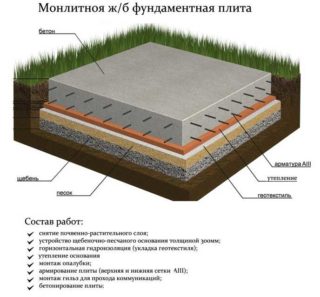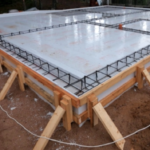Among all types of foundations for private houses and garages, strip is the priority. It is reliable, good for most soils, and not too expensive. However, the specificity of the region, soil, groundwater often forces the strip foundation to be deeply deepened, which becomes unprofitable for small buildings. In this case, the foundation slab comes to the rescue, which is not inferior in terms of bearing capabilities. The monolithic slab promotes even load distribution and is suitable even for heavy structures.
The device and application of a monolithic slab
- Digging a pit. Its size should be 1 m larger than the foundation, according to the drawing. The side walls are made with a slope of 10-20 degrees. The soil is carefully compacted. The bottom of the pit must be solid.
- If necessary, reservoir drainage is made - transverse trenches are prepared in which geotextiles and pipes are laid. All this is again covered with geotextiles.
- A rammed pillow is made of sand, ASG, crushed stone. It is spilled with water, thoroughly rammed. It is made layer by layer with alternate compaction or one layer of sand and pebble mixture. Serves for damping loads from the soil. The pipes are laid later - special trenches are left under them.
- Geotextile. Prevents erosion, silting of the sand layer, reinforces it. Dornit is positioned in several ways. The main one is between the bottom of the trench and the sand bed. Sometimes the compaction layers are separated to avoid mixing. Also, the sand layer is separated from the concrete preparation.
- The formwork is placed strictly vertically from 40 mm boards or plywood. To prevent bursting, stops are constructed from the outside.
- A layer of concrete preparation. To save money, it is neglected, however, it is useful for leveling the base, the correct location of waterproofing, insulation materials. It is made of inexpensive cement M100 with crushed stone. Layer thickness - up to 100 mm.
- Waterproofing layer. Separates wet soil bedding from the concrete subfloor. Materials based on polymer-bitumen are considered the best. The optimal laying pattern assumes 2 layers of spacer. The use of roofing material is allowed.
- Monolithic slab. Thickness is calculated. Required concrete strength from M300 and mobility P3. Less mobile will form voids. In liquid, heavy fractions will settle to the bottom. Deep vibrators are used for compaction. The vibrator mace should be smaller than the size of the reinforcement mesh. It is desirable to fill in once. If this is not possible, in horizontal layers during the shift. You cannot do vertical separation with a layer - the concrete will crack.
- Reinforcing belt. In the classic version, it is a volumetric reinforcement lattice, connected with clamps or wire. On all sides, the distance to the reinforcement must be at least 50 mm to prevent corrosion. Installed on top of concrete preparation.
The simplest thing is to fill in a homogeneous monolithic slab of the same thickness over the entire area of the base. There are more complex solutions for monolithic slab foundations for a house.
The uniformity of the load on the base makes the slab indispensable on soils with low bearing capacity.Low manufacturing complexity contributes to self-priming.
Reinforced concrete foundation monolithic slab is good for private housing construction, garages, baths on floating clay soils, heaving loams, in places with a high groundwater table. It does not require deep placement for its device. Proximity to the surface will be a stabilizing factor. Heavily soils will not have a negative impact, on unstable soils - the base will "float" following the movement of the soil along with the erected structure.
Methods for creating a foundation slab

Externally, the base looks like a uniform thickness of a reinforced concrete slab 0.25–0.5 m over the entire area of the building.
Types of monolithic slab foundations:
- Classical. On a cushion of gravel and sand. The thickness of the backfill can reach 2/3 of the depth of the pit and depends on the size of the fertile layer.
- Russian high strength. Foundations with stiffeners under the load-bearing walls. It is used on heavily heaving soils for massive buildings. For light houses, it is allowed to reduce the thickness of the slab to 10 cm.
- Swedish insulated plate. Underfloor heating is inserted into the formwork from non-removable insulation blocks, reinforcement is installed, and concrete is poured. All communications are located at a depth, under a sand cushion. The most reliable pipes are selected, since it is impossible to disassemble the foundation.
The slab foundation is made of prefabricated reinforced concrete structures installed end-to-end. It is much easier than pouring the foundation slab once. But there is a catch here - the rigidity of the resulting base is low. With any serious heaving of the soil, the building will deform. Therefore, the method is rarely used - mainly for small buildings that fit on 1 slab.
Determination of base thickness
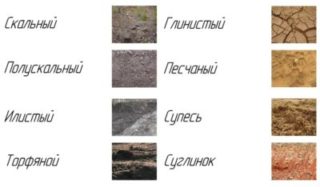
High-quality planning of pouring a slab for a garage or house requires geological surveys. This allows you to find out the location of soil layers, the presence of "top water". This is the basis for calculations.
Different types of soils are characterized by their bearing capacity:
- in coarse, gravel, crushed stone, it is the largest - 5-6 kgf / cm²;
- sands are large, gravelly - 3.5–4.5 kgf / cm²;
- fine and medium sands - 1–3.5 kgf / cm²;
- sandy loam - 2-3 kgf / cm²;
- loams - 1-3 kgf / cm²;
- hard clays - 3–6 kgf / cm²;
- plastic clays - 1-3 kgf / cm².
The plate pressure must be included in these parameters together with external loads. However, when calculating the required power of the plate, they operate with the numbers of the optimal specific pressure. The calculated value should not deviate by more than 20-25%. A slab that is too heavy will sink into the ground over time. The lung will be too mobile. It will skew even with slight soil movements.
Considering that on soils with a high bearing capacity, the construction of a slab does not make sense, the following values remain:
- dense or dusty sands - 0.35 kgf / cm²
- sands of medium density - 0.25 kgf / cm²
- sandy loam - 0.5 kgf / cm²
- loam - 0.35 kgf / cm²
- hard clays - 0.5 kgf / cm²
- plastic clays - 0.25 kgf / cm².
On sandy loams, it is possible to place a tape type, and hard clays can be deceiving. With a close location of aquifers, a sharp loss of the bearing capacity of the soil is possible, the plate will simply sink. A bored pile foundation can help here. In both cases, in-depth research is required.
Advantages and disadvantages
- Expanded capabilities on soils with complex geology, which are not suitable for a strip base due to low bearing capacity and high heaving. However, on clearly swampy soils with a strong subsidence, it will be ineffective, yielding to a pile with a base much lower than the freezing depth.
- Dense monolithic foundations are suitable for the construction of heavy multi-storey structures. Professional calculations of the distribution of forces will allow you to save money when designing apartment buildings.
- A minimum of effort to arrange the foundation. Excavation works are small, since the buried part is small. However, when designing very heavy or large structures, this advantage will be fragile and will begin to lose to tape bases.
- A foundation slab is a good base for a ground floor or basement floor. This is an important advantage. With good insulation, the floor becomes immediately warm. Water heating can be installed in a multi-layer plate.
- The slab is not a construction object of increased complexity. Digging a pit, pouring concrete, tying reinforcement can be done with your own hands. The skill comes quickly.
The work is monotonous and tedious. However, having enlisted the support of relatives and friends, you can mount it yourself without serious construction skills. For a small construction team, pouring a monolithic foundation for a private house will be a doable task.
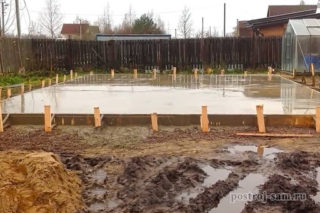
Minuses:
- In areas with a pronounced instability of the soil, the “floating” of the base occurs with a large amplitude, and the forces from below are applied unevenly. The slab begins to experience colossal bending loads.
- Small linear deformations are quite likely. Some materials are sensitive to them. When "floating" the slab can tilt and the walls deviate from the vertical. For wooden buildings, this is not critical, but for block, brick structures, the stresses increase when a certain height is reached. The appearance of cracks in the upper part of the buildings is possible.
- A number of installation operations will require the involvement of specialists and technology. A vibratory plate is needed for high-quality ramming. Tying the reinforcement cage will require a knitting gun or special clamps, waterproofing - a gas burner. It is more convenient to pour a large volume of concrete with a single-stage pouring using a construction mixer. It is advisable to assemble the stove in 1 day.
- With significant differences in height, such a foundation is completely impossible or unprofitable.
- A basement, a cellar, a viewing hole are equally impossible when erecting a monolithic slab. Its essence is to rest the entire area on the ground and, if necessary, slide evenly over it. An exception is the specific structure of a number of slabs with grillages for load-bearing walls or reinforcing tabs, from which the recessed part of the wall is already led. But this is a difficult and expensive pleasure.
- During construction, it is mandatory to lay all communications, including power cables, water supply, sewerage, ducts. This is more likely not a drawback, but a specific feature of the technology, but it complicates the construction process.
- The cost of a deep monolithic foundation for a private house is high. Sometimes it reaches 50% of the cost of the entire building. With a shallow slab, everything is not so scary. Although even a few extra centimeters quickly grow into cubes of volume.
Double-deck reinforcement will require a significant increase in reinforcement and concrete. This is where the strip foundation wins. But the slab is at the same time an overlap in the building - a sub-floor with good waterproofing, often with insulation. This reduces the total cost of the estimate, somewhat reduces the total volume of work, its laboriousness.
The high cost is partially offset by labor costs, and the ease of installation is partially offset by the increased consumption of building materials.
Features of the construction of a slab foundation
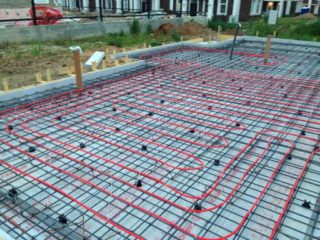
The floating slab works well on heaving soils and prone to strong subsidence - fine sandy, peaty, clay, loam. The only alternative to strip bed in water-saturated soils, on embankments.It is not recommended to use it in landslide areas with swampy silt.
Monolithic reinforced concrete slabs are good for strong vertical, moderate horizontal movements. It is allowed to introduce ready-made reinforced concrete piles into the upper stiffeners, tightly fastened to the main foundation.
On medium-gravelly soils, along with a monolithic slab, prefabricated with installation on concrete is allowed.
On slightly loose soils, monoliths filled with expanded clay concrete or rubble are suitable. Stiffeners are allowed at the top and bottom. Special fastenings are not necessary - the building remains on the crossbars under the influence of gravity.
The greater the weight of the building, the more reliable the adhesion to the foundation, the less horizontal movements in the ground. It is advisable to produce a slab immediately with insulation for use as a subfloor.
The fundamental rule is the exact execution of all stages of construction and the use of high quality concrete. Only in this case the foundation will last for many years.

